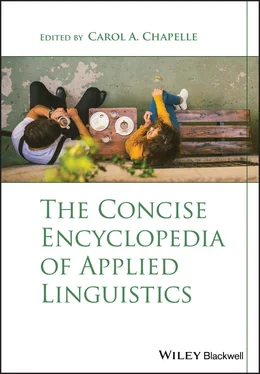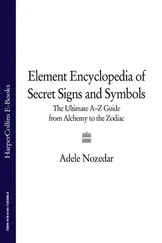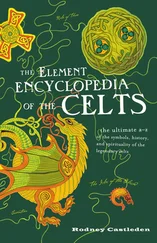Robinson's Model of the Relationship between Attention and Memory
Robinson's (1995a) model of the relationship between attention and memory neatly reconciles Schmidt's notion of noticing (which involves awareness) and Tomlin and Villa's notion of detection (which does not imply awareness). In this model, detection is strategically placed at an earlier stage in the acquisitional process when compared to noticing. In other words, linguistic information may be detected and taken in by the learner but if this information is not accompanied by awareness, then the chance of this information being further processed is relatively minimal. Noticing, according to Robinson, is “detection plus rehearsal in short‐term memory, prior to encoding in long‐term memory” (1995a, p. 296). Like Schmidt, Robinson assumes that noticing does involve awareness and that it plays an important role in L2 learning.
Leow's Model of the L2 Learning Process in ISLA
Leow's (2015a) model of the L2 learning process in ISLA also underscores the role of attention at the input processing stage but, like Tomlin and Villa (1994), does not posit a crucial role for awareness at this stage. He provides a more fine‐grained notion of input processing by dividing this stage into three phases, each with attentional resources that may incorporate cognitive registration, awareness, and depth of processing, which in turn may lead to three types of intake: attended intake, detected intake, and noticed intake. All three phases are characterized by low processing and, crucially, all types of intake may disappear from working memory if not further processed.
As can be seen from the tenets of the different theoretical underpinnings regarding the roles of attention and awareness in SLA, the facilitative role of attention in L2 development is generally accepted while the role of (un)awareness is not without debate. More specifically, while both Schmidt's noticing hypothesis and Robinson's model posit a crucial role for awareness, Tomlin and Villa's and Leow's models do not. What is not controversial, then, is that attentional resources do need to be allocated to specific linguistic (grammatical, lexical, phonological, etc.) information in the input. However, whether these attentional resources need to be accompanied by learner awareness to process the linguistic information in the input for intake and subsequent learning remains debatable in the SLA literature.
Attention/Noticing and Learning: Empirical Evidence in SLA
There are several strands of SLA research that are explicitly or implicitly premised on the role(s) of attention, or noticing (attention plus a low level of awareness), or both, in L2 development. These strands include processing instruction, interaction or feedback, learning conditions, input/textual enhancement, focus on form, and so on. Attention/noticing has been measured by a variety of instruments in SLA studies that include both online (e.g., eye‐tracking, think aloud protocols, uptake charts, note taking, making check marks) and offline (e.g., questionnaires, learning diaries, verbal reports, stimulated recall protocols) measures.
Quite a large range of linguistic items has also been empirically investigated and these include Spanish imperatives, imperfect and preterit forms, present perfect forms, relative pronouns, past conditional; Finnish locative suffixes; English possessive determiners, relative clauses; French past participle agreement, and so on. Different levels of language experience have also been explored, ranging from beginner learners of an L2 to intermediate to advanced levels. Amount of exposure is also differential, ranging from less than an hour to over several days.
Overall, the findings of these studies provide strong support for the role of attention, or noticing, or both, in L2 development. At the same time, concurrent data gathered via the eye‐tracking procedure (e.g., Godfroid, Boers, & Housen, 2013) and think aloud protocols (e.g., Leow, 2001) also reveal that not all L2 data that have been attended to or noticed (intake) are subsequently processed and internalized into the L2 learner's system. In addition, the research designs of many of these noticing studies did not methodologically tease out the specific role awareness played while learners were attending to incoming L2 data. To this end, the next section reports on the definition and operationalization of the construct of learner awareness and the findings of empirical studies that methodologically addressed the role of this construct in L2 development.
Awareness and Learning in SLA
Awareness is defined in SLA as “a particular state of mind in which an individual has undergone a specific subjective experience of some cognitive content or external stimulus” (Tomlin & Villa, 1994, p. 193). Awareness, according to Leow (2001), may be demonstrated through (a) some resulting behavioral or cognitive change, (b) a meta‐report of the experience but without any metalinguistic description of a targeted underlying rule, or (c) a metalinguistic description of a targeted underlying rule. In addition, the operationalization and measurement of what constitutes awareness in SLA is methodologically thorny and varied. Leow, Johnson, and Zárate‐Sández (2011) provide a methodological review of relevant studies in both SLA and non‐SLA fields and call for a finer‐grained approach to the study of the construct of awareness. This finer‐grained approach advocates, in any report on the role of awareness in L2 development, careful consideration of several aspects of the research design that include (a) where awareness is measured (at the stage of encoding/construction that is online, viewed as a process versus at the stage of retrieval/reconstruction that is offline and viewed as a product ); (b) what kind of item is being targeted; and (c) how awareness is measured (the measurement instrument).
Studies addressing the role of awareness in L2 development can be categorized into two methodological approaches dependent upon the researcher's perspective of awareness as a process or a product (Leow, 2015b). As a process, that is, during the encoding of L2 data, awareness is measured either concurrently or online via the use of mainly think aloud protocols (e.g., Leow, 2000) or eye‐tracking (e.g., Godfroid & Schmidtke, 2013). As a product , that is, knowledge existing in the learner system, the measurement is offline or non‐concurrent and includes the use of stimulated recalls, offline verbal reports, questionnaires, grammaticality judgment tasks, timed oral and written tests, subjective measures such as confident ratings, source attributions, and so on (e.g., Robinson, 1995b; Leung & Williams, 2011; Rebuschat, Hamrick, Sachs, Riestenberg, & Ziegler, 2015). While the use of online verbal reports has been challenged for the potential reactive nature of this measurement, offline measures run the risk of veridicality or memory decay and raise the methodological issue of whether such operationalization and measurement of the construct awareness does indeed refer “to the same construct, that is, whether the PRODUCT accurately reflects the PROCESS” (Leow & Donatelli, 2017, p. 190, uppercase original).
Empirical Evidence for the Role of Awareness in SLA
Overall, many of the studies that have independently investigated the construct of awareness as a process by employing online verbal reports to operationalize and measure this construct (e.g., Medina, 2016; see Leow & Donatelli, 2017 for a recent timeline on awareness studies) appear to provide empirical support for the facilitative effects of awareness on foreign‐language behavior and learning. Several levels of awareness have also been reported at the levels of noticing and understanding (Schmidt, 1990) and an intermediate level of awareness between the levels of noticing and understanding, namely, awareness at the level of reporting (Leow, 2001). In addition, higher levels of awareness appear to correspond with higher depth of processing (Leow, 2015a), higher levels of intake and learning and the presence of hypothesis testing and rule formulation.
Читать дальше












